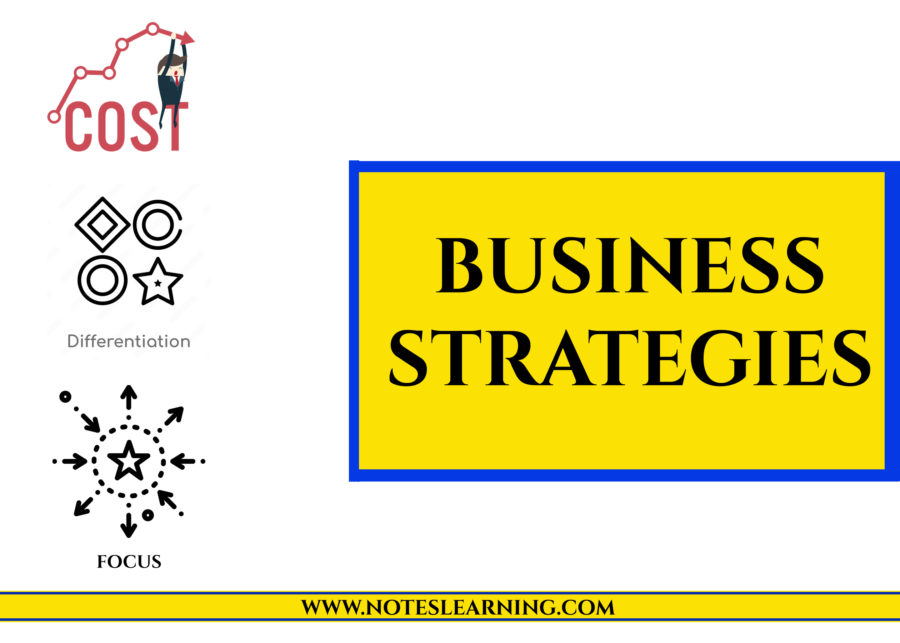Introduction to Business Strategies
Business Strategies generally focuses on improving the competitive position of a company, business unit or products/services within a specific industry. Strategies directly affect the corporate strategies of the company as the business unit’s performance directly reflects the company’s overall performance. Business strategies can be competitive or cooperative. Competitive nature deals with the competition against all the existing and potential competitors. Meanwhile cooperative nature is an association with other companies to out-perform competitors. Business strategies act on how the company or its units should compete or cooperate in each industry.
MICHAEL PORTER’S COMPETITIVE STRATEGIES
Michael Porter has proposed two ‘generic’ competitive strategies, in support with business strategies. They are: Lower Cost and Differentiation. These strategies are considered generic because any business can adapt to these strategies. Lower cost generally deals with that business operation which design, produce and market a product or service at much lower rate than any of the existing competitors. Differentiation Strategy is that approach where a company provides a unique and superior value to the buyer in terms of product quality, design and service.
Porter linked these generic strategies with the scope of the market they are operating in and developed a model. When generic strategies acted in a mass market, porter proposed terms as cost-leadership and differentiation. Meanwhile, when those generic strategies were applied in narrow or niche markets, porter termed them as cost-focus and differentiation focus.
Cost Leadership
Aiming to cater to a broader mass market, it is a lower-cost strategy that provides products and services to a larger audience. In such a strategy, it is essential to measure the internal factors of a company, especially its ability to operate on an efficient scale to control cost and be efficient. A cost-leader firm will try to provide a lower price for its product or services than its competitors and still have a profitable business. Some of the cost leaders are Wal-Mart (discount-retailing). McDonald’s (fast-food restaurants), Dell (computers), Alamo (Rental Cars), Timex (Watches). Cost leadership is also an obstacle for new competition as they need to provide the product at the competitors price or lower. All these above mentioned cost leaders are also the leader in the market share of their respective industry and thus, enjoy higher profit.
Differentiation Strategy
It is a differentiation strategy that aims to act in a larger market. This strategy focuses on actively creating unique products and services for its customers. The company charges a premium price for such unique products or services. Company’s adapting to this strategy will provide a unique experience to the customers that they feel associated with and loyal to the brand.
Loyalty and association factors actively neutralize the price sensitivity of the customer. Some of the companies with these strategies are; Walt Disney (Entertainment), BMW (Automobiles), Nike (Athletic Shoes), Apple Computers (Computer and cell phones). They provide premium products with premium pricing. The band loyalty and quality of the product or service help to create barriers for the competitors.
Cost Focus
A niche market is the focus of a low-cost competitive strategy known as cost focus. The product and services are exclusive to other customers and by adapting this strategy to a particular segment, companies tries to cater all the need without impacting its cost advantage. It generally competes with the well-known brands and provides similar products at comparatively competitive prices but keeps its overhead cost exclusive to its targeted consumers. For instance; Potlach competes with Procter & Gamble’s category but have their own specific customers.
Differentiation Focus
Differentiation focus concentrates on a particular buyer group, product line segment or geographic market. Here, companies with differentiation focus cater the special needs of the customers of the targeted market segment. There may be similar products available in the market but unique propositions make buyers loyal. Differentiation focus strategies have distinction in their product and service and their customer enjoys this supremacy of uniqueness. Some of the companies with differentiation focus strategies are: Morgan Motor Car Company (Classic British Car), Nickelodeon (Cable for Children) etc.
Porter’s Competitive Strategies : Risk Association
| Risk in Cost Leadership | Risk in Differentiation | Risk in Focus |
| High chance of imitation | Higher chance of imitation. | Target market can be unattractive after operation. |
| Frequent change in technology. | Bases for differentiation become less important. | Demand disappears |
| Proximity in differentiation is lost. | Regular differentiation is difficult | Focus strategy is also imitable |
| Cost proximity is lost. |
Porter has argued that companies with these two generic competitive strategies will thrive in the market. Those who are stuck in the middle of a competitive market with no competitive advantage and below the market performance, fail and end up with bankruptcy. And there are very few companies who are successful in adapting both the generic competitive features in their operation. Honda and Toyota are two companies with both of the generic competitive strategies in their model and are successful.
| Generic Strategy | Required Skills and Resources | Common Organizational Requirement |
| Cost Leadership | Sustained capital investment and access to capital Process engineering skills Intense supervision of labor Low-cost distribution system | Tight cost control Frequent, detailed control reports Structured organization and responsibilities |
| Differentiation | Strong marketing abilities Product engineering Creative flair Strong capability in basic research Corporate reputation for quality for technological leadership Strong cooperation from channels | Strong coordination among functions Subjective measurement and incentives instead of quantitative measures Amenities to attract highly skilled labor, scientists or creative people |
| Focus | Combination of the above policies directed at the particular strategic target | Combination of the above policies directed at the particular strategic target. |
ELEMENTS OF STRATEGY FORMULATION
BLUE OCEAN STRATEGY

